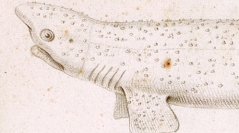

 Zoosystema
42 (13) - Pages 173-193
Zoosystema
42 (13) - Pages 173-193The Bramble shark, Echinorhinus brucus (Bonnaterre, 1788) was first described by Broussonet in 1780 based on a type that has been lost and its unpublished illustration. In his description of the species Broussonet says: “M. de Jussieu a bien voulu nous en communiquer un dessin fait par Mrs. de l’Académie, envoyés par ordre du Roi, vers la fin du dernier siècle, pour faire des observations anatomiques sur les bords de l’Océan ; il est désigné sous le nom de Brucus. Nous avons vu au Cabinet du Roi l’individu d’après lequel cette figure avoit été faite”. [Mr. de Jussieu has kindly communicated to us a drawing made by Mrs. from the Academy, sent by order of the King, towards the end of the last century, to make anatomical observations on the shores of the Ocean; it is referred to as Brucus. We have seen in the cabinet of the King the individual according to which this figure had been made]. The pursuing of the clues contained in this quotation made it possible to find in the archives of the Muséum national d’Histoire naturelle the collection containing the illustration of the type, made in 1680 on the Bayonne coast, as well as the authors that had subsequently been anonymized after the French Revolution, namely the anatomist Joseph-Guichard Du Verney and the astronomer Philippe de La Hire, members of the Académie royale des Sciences. The beautiful anatomical plates of the collection were intended to serve Claude Perrault to illustrate the fourth volume of the Mémoires pour servir à l’histoire naturelle des animaux dedicated to ichthyology but whose publishing was curtailed. At the beginning of the 19th century, Blainville was the last zoologist to examine the type and to produce a second unpublished manuscript illustration. This iconic shark, formerly exploited, has been extirpated from European waters and is now on the brink of global extinction. Its early disappearance since the beginning of fisheries industrialization has gone unheeded due to the lack of historical summaries concerning this species. Revealing the story of its description constitutes a first step towards filling this knowledge gap.
Académie royale des Sciences, Cabinet du Roi, Du Verney, La Hire, Broussonet, Duhamel du Monceau, Blainville, manuscript, conservation, sharks, holotype